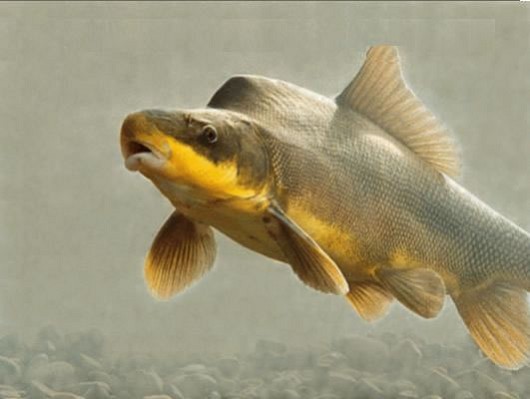Razorback Sucker
-
Scientific NameXyrauchen texanus
-
NativeYes
-
Identification
 Razorback sucker. Photo taken at the Ouray National Fish Hatchery by Mark Fuller, a biologist for the US Fish and Wildlife Service, and provided by Tim Modde, USFWS.
Razorback sucker. Photo taken at the Ouray National Fish Hatchery by Mark Fuller, a biologist for the US Fish and Wildlife Service, and provided by Tim Modde, USFWS.- Sucker body, rarely exceed 50 cm SL, max 76 cm SL (5-6 kg)
- Presence of bulging fontanel and sharp keel anterior to dorsal fin
- Sub-terminal mouth: few papillae, lower lip with deep medial notch,
- Olive to dusky back, brownish sides, yellow-orange to white underside
- Spawning males: bright yellow underside, orange side bands, breeding tubercles on pelvic, anal, and caudal fins
- Spawning females: similar coloration, less developed tubercles may be present
- Fin rays: dorsal 13-16, anal 7
- Lateral line scales: 68-87
-
Life History
Razorback Suckers are listed as an endangered species and in California fail to have any remaining naturally propagating populations. Razorback Suckers primarily inhabit large slow moving sections of river within the Colorado River drainage, though they also inhabit scattered lakes and basins. They are found in deep pools, oxbow lakes, and backwaters within a stream and may also move into reservoirs or gravel pits. During high flows the suckers have the keel and hump (acting like a spoiler) to help them resist being pulled downstream. Razorback Suckers are usually found above mud and sand and may have historically moved into the floodplain. Juvenile suckers tend to live in shallow water such as man-made canals and ditches. Larval suckers feed on detritus, diatoms and algae. As they grow they begin to consume rotifers and planktonic crustaceans. Eventually as they become more bottom oriented they feed on chironomid larvae and small insects. Adult suckers tend to swim in small schools and feed on the bottom of a stream. In lakes the suckers move into deeper water and feed on detritus, algae, zooplankton, and aquatic insect larvae. Razorback Suckers grow at an average rate of 7-8 mm per year for about the first 5 years of life, at which time they reach sexual maturity. Under optimal conditions they may reach 40 cm TL in their first year. In the 1980s and 1990s Razorback Suckers in the lower Colorado River were aged at 24-45 years old. Sexually mature males form loose shoals in spawning sites and await the females in November or December. Once the females arrive, the fish spawn for the next two months. Each female is surrounded by two or more males. The female and male fish release eggs and milt simultaneously. Female suckers spawn repeatedly until they release a total of 36,000 to 140,000 eggs. The eggs stick to the substrate for the 1-2 week incubation period. The emergent larvae consume a yolk sac for another 7-12 days before drifting downstream. The larvae may thrive in isolated ponds or backwaters, but are often eaten when in the presence of alien predators.
-
Links to Other ResearchN / A
